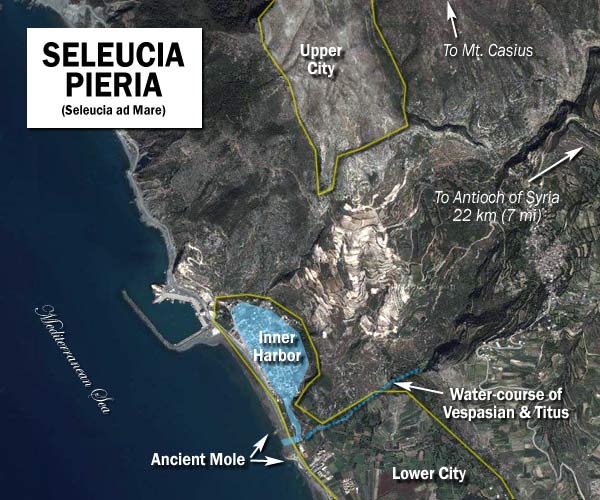
Around the year 300 BCE, Seleucus I Nicator, one of the companions and successors of Alexander the Great, founded this city to be the port for his capital city of Antioch of Syria, naming it after himself. Some evidence suggests that an earlier town existed, which some sources refer to simply as palaeopolis (“Old City”). Seleucus fortified the city and built its imposing acropolis. This Seleucia is also called “Seleucia Pieria” or “Seleucia ad Mare” (“Seleucia by the Sea”) to distinguish it from other cities Seleucus founded or renamed throughout his kingdom, the most famous of which was his first capital, located on west bank of the Tigris River in Mesopotamia.
Seleuicia was a prize that the imperialistic Ptolemies of Egypt coveted. When Ptolemy III Euergetes captured it in 246 BCE, he made it the beachhead for extending his domination over Cilicia. Only in 219 BCE was the Seleucid Antiochus III “the Great” able to recapture it and drive out the Ptolemaic invaders from Asia Minor (see Polybius 5.58-60). Seleucia came under Roman control when Pompey wrested Syria away from Antiochus XIII Asiaticus and made it a Roman province.
According to Acts 13:4, Barnabas and Saul (who after 13:9 Luke consistently calls Paul) sailed from Seleucia to Salamis in Cyprus at the beginning of their First Missionary Journey. Although Acts does not mention Seleucia again, we can infer that Paul and Barnabas made landfall there on their return voyage (Acts 14:26). Paul likely passed through Seleucia again at the close of his Second Missionary Journey (see Acts 18:22).
Adjacent to Seleucia and jutting up from the sea to a height of 1,621 m. (5,318 ft.) soars Mount Casius, celebrated in ancient times for its beauty. According to a 19th-century visitor, it was covered with myrtle trees at its base, then oaks higher up, succeeded by pines, followed by birch. At the very top is only naked limestone. At its top observers could witness sunrise while the world below was still enveloped in darkness. This curious phenomenon brought the Emperors Hadrian and Julian to see it for themselves.
The city’s harbor was one of the main reasons for the city’s existence. It consisted of an outer harbor protected from storms by an artificial mole that extended out from the shore. This outer harbor was connected by a channel to an inner harbor, expanded over the centuries into a huge basin (the blue oval above, now filled in), making it one of the largest in the Mediterranean and a major Roman naval base. Like many ancient coastal cities, however, Seleucia’s outer harbor faced the ongoing threat of becoming unnavigable because of accumulating silt.
Shortly after the time of Paul, the Romans finally solved this problem and at the same time were able to control the flooding that heavy rains inflicted on the lower city. During the reigns of Vespasian and Titus, engineers created an channel that collected water off the mountain above the city and directed it through a series of two tunnels directly into the harbor. Whenever the region experienced heavy rains, the ensuing flood would rush through the channel into the harbor, carrying the silt with it out into the Mediterranean Sea. This water channel, with its inscription, is one of the main tourist features of the site today.
Seleucia continued into Byzantine times; its bishop was among those at the Council of Nicea in 325 CE. Its importance came to an abrupt end, however, when a great earthquake and resulting tsunami, probably in May 526 CE, devastated the city and its harbor.
Today surviving remains in the lower city include the mole, an amphitheater, city walls with its gates, and the foundations of a Byzantine church, as well as the waterworks already noted. The acropolis has a wide staircase still extant, as well as the ruins of the city walls and the foundations of a number of buildings. Extensive excavations took place from 1937 to 1939 as a part of the Princeton excavation of Antioch, unearthing in the lower city houses, the market gate, and a Byzantine church called the Martyrion. In the upper city excavators examined a large Doric temple that dates back to before the time of Christ.
Want to go deeper?
Photos of Dick Ossemann – Watercourse of Vespasian and Titus |
